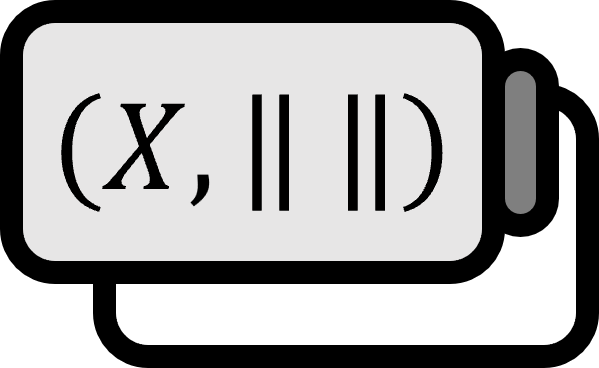L² Space
Definition1
The set of sequences that are square-convergent is denoted as $\ell^{2}(\mathbb{N})$.
$$ \ell^{2}(\mathbb{N}) := \left\{ \left\{ x_{k} \right\}_{k \in \mathbb{N}} : x \in \mathbb{C}(\text{or } \mathbb{R}),\quad \sum\limits_{k \in \mathbb{N}} \left| x_{k} \right|^{2} \lt \infty \right\} $$
It can also be simply denoted as follows.
$$ \mathbf{x} = \left\{ x_{k} \right\}_{k \in \mathbb{N}} = (x_{1}, x_{2}, \dots, x_{n}, \dots) $$
Description
$\ell^{2}$ space is a special case when $\ell^{p}$ space is $p=2$, and it is the only $\ell^{p}$ that is an inner product space.
Properties
The vector space $\ell^{2}$ is
- a Hilbert space, i.e., a complete inner product space. The inner product is given as follows. $$ \braket{\mathbf{x}, \mathbf{y}} := \sum\limits_{k \in \mathbb{N}} x_{k}\overline{y_{k}} $$
- a Banach space, i.e., a complete normed space. The norm is given as follows. $$ \left\| \mathbf{x} \right\|_{2} := \left( \sum\limits_{k\in \mathbb{N}} \left| x_{k} \right|^{2} \right)^{\frac{1}{2}} = \sqrt{\braket{\mathbf{x}, \mathbf{x}}} $$
- a metric space. The distance is given as follows. $$ d(\mathbf{x}, \mathbf{y}) := \left( \sum\limits_{k\in \mathbb{N}} \left| x_{k} - y_{k} \right|^{2} \right)^{\frac{1}{2}} = \left\| \mathbf{x} - \mathbf{y} \right\|_{2} = \sqrt{\braket{\mathbf{x} - \mathbf{y}, \mathbf{x} - \mathbf{y}}} $$
- The Cauchy-Schwarz inequality holds. $$ \left| \braket{\mathbf{x}, \mathbf{y}} \right| = \left| \sum\limits_{k \in \mathbb{N}} x_{k}\overline{y_{k}} \right|^{2} \le \left( \sum\limits_{k \in \mathbb{N}} \left| x_{k} \right|^{2} \right) \left( \sum\limits_{k \in \mathbb{N}} \left| y_{k} \right|^{2} \right) = \braket{\mathbf{x}, \mathbf{x}}^{\frac{1}{2}} \braket{\mathbf{y}, \mathbf{y}}^{\frac{1}{2}} $$
Theorems
- Every infinite-dimensional separable Hilbert space $H$ is isometrically isomorphic to $\ell^{2}$.
- Bounded linear operators to the Hilbert space $H$ and their adjoint operators $T$ are as follows. When $\left\{ \mathbf{v}_{k} \right\}$ is a sequence of $H$, $$ T \left\{ c_{k} \right\}_{k \in \mathbb{N}} := \sum_{k \in \mathbb{N}} c_{k} \mathbf{v}_{k}, \qquad T^{ \ast } \mathbf{v} = \left\{ \left\langle \mathbf{v} , \mathbf{v}_{k} \right\rangle_{H} \right\}_{k \in \mathbb{N}} $$
Ole Christensen, Functions, Spaces, and Expansions: Mathematical Tools in Physics and Engineering (2010), p65-66 ↩︎
